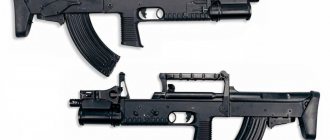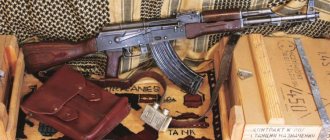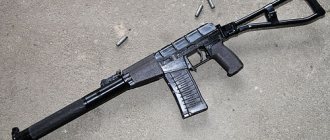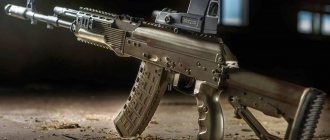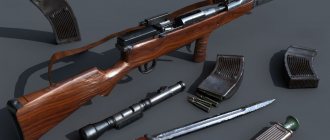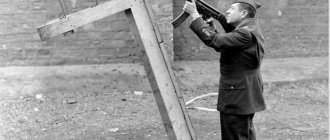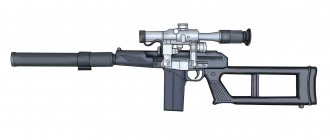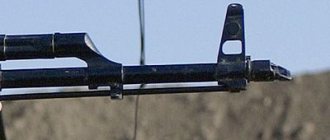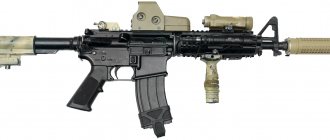- Laser tag in St. Petersburg
- Reviews of real weapons
- Slot machines
- AN-94 "Abakan"AN-94 "Abakan"
In the future, the Nikonov AN-94 assault rifle was supposed to become a replacement for the legendary Kalash, which recently gave way to the 100 series. The Abakan project envisaged the development of a fundamentally new weapon with a caliber of 5.45 mm. Unfortunately, the final version did not receive the desired popularity. However, today it is effectively used by individual special forces.
The Nikonov assault rifle officially began to arrive in the Russian Army in 1994. They were planned to replace the obsolete AK-74 and AKM, but the difficult financial situation after the collapse of the USSR and a number of design flaws in the new product forced the government to abandon the idea of mass production.
The highlight of the Nikonov AN-94 “Abakan” assault rifle
The unique design of the AN-94 assault rifle only visually resembles the popular AK series. The box with the barrel is placed on a special carriage with guides. Under the influence of recoil, it can move smoothly inside the housing. There is a return spring located under the receiver. Since the barrel chamber constantly moves when firing, but the magazine remains in place, the designer had to develop a new two-stage cartridge feeding mechanism.
Unlike the AK AN-94, the Abakan can fire with a cutoff of 2 rounds. In this firing mode, both shots are fired at a speed of 1800 rpm. The bolt box will gently move back inside the body under the influence of recoil. It reaches its starting position after both ammunition has left the barrel. Thus, the recoil impulse does not affect the trajectory of the bullets and accuracy. In long burst mode, firing from the AN-94 is implemented identically to the AK-74 and AKM.
heading_title
In 1993, at an arms exhibition held at the headquarters of the elite Guards Taman Division near Moscow, a mysterious new machine gun was presented. This strange machine gun was displayed next to regular AK-74 assault rifles and RPK-74 light machine guns, the division's standard small arms. The new machine gun had the designation ASN, which, as it later turned out, stood for “Nikonov special machine gun.”
The soldiers present at the exhibition could not provide any additional information about the new weapon beyond the basic characteristics that were given on the poster. However, soon after the end of the exhibition, new information appeared regarding the ASN, indicating that it was a prototype of a new and improved assault rifle in the truest sense of the word. But the official status of the machine remained a mystery for a long time. Only in 1996, the Russian Ministry of Defense dispelled this mystery, announcing that the ASN had passed all military tests and was officially accepted into service under the designation “Avtomat Nikonov-94 (AN-94)”, named after Gennady Nikonov, the head of the design bureau that created new weapon. The numbers “94” indicate the year in which the machine gun was adopted by the Russian Army with the prospect of eventually replacing small arms of the AK-47/AKM/AK-74 family.
According to rumors leaking out of Russia, the “grand old man” of Russian small arms, Mikhail Kalashnikov, was hostile to the new assault rifle, since the design bureau headed by his son was also competing for the honor of developing a new generation of Russian automatic small arms. However, over time it became clear that, despite Kalashnikov's objections, the AN-94 would become the new standard weapon for the Russian infantry.
The history of the creation of the AN-94 began more than twenty years ago, when the new AK-74 assault rifle was adopted. At that time, the 5.45x39 mm cartridge, for which the AK-74 was created, was a tacit recognition by the Soviet military of the effectiveness at close and medium distances of small-caliber bullets with high muzzle velocity. This was first shown by the experience of combat use of the American M16 A1 automatic rifle chambered for 5.56x45 mm during the Vietnam War. The ammunition for the new Soviet assault rifle was converted from the “intermediate” 7.62x39 mm cartridge of the 1943 model. Although
ASN assault rifle, caliber 5.45 mm. This 1980s example was created by G.H. And also as a convoy within the framework of the Abakan program. It was followed by two more developments, AS and ASN. The last one was completed in 1987. |
5.45 mm ASN assault rifle. |
The lethal force of a 5.45 mm bullet provided a high lethal effect (the Afghan mujahideen nicknamed it a “poisoned bullet”), the Soviet military was dissatisfied with how the AK-74 performed in a combat situation. It was probably then that the leadership of the Soviet Army came to the conclusion that the AK-74 would mark the end of the Kalashnikov assault rifle. Further improvements to the basic design could not lead to anything, and by the beginning of the new century it was necessary to create a fundamentally new machine gun.
The main requirement for the new machine gun was that the probability of a hit (firing efficiency) be one and a half to two times higher than the corresponding indicator of the AK-74. Also, apparently, the military decided that in order to increase the probability of a hit, it was necessary to reduce the recoil force. Ironically, this consideration was partly the reason for the creation of the AK-74. The recoil force of the AK-74 assault rifle is reduced compared to the previous AK-47 and AKM models, created with the old 7.62x39 mm cartridge, but this is primarily due to the reduced caliber ammunition and, to a lesser extent, the very successful design of the combined muzzle flash suppressor brake installed on the AK-74. However, the reduction in recoil force was considered insufficient, and work began on creating a new machine gun based on the most advanced technologies, which was to replace the entire Kalashnikov family of small arms. In addition
In addition to increased firing efficiency and reduced recoil force, the new machine gun had to meet even more stringent requirements for reliability and reliability.
The development program for the new machine gun was named “Abakan” in honor of the town in Siberia where the test site was located, where the tests of the presented prototypes were mainly carried out. This was the reason that Western experts, when they first saw the new AN-94 in the bows of Russian army soldiers, mistakenly called it “Abakan”. To add to the confusion, the Russian military used the term “Abakan” to collectively refer to all the candidates competing to become the new Soviet machine gun. According to Gennady Nikonov, the creator of the AN-94, all leading Soviet small arms designers submitted their designs for testing, and no fewer than eight different assault rifles were tested during the program. As a result, preference was given to the Nikonov assault rifle, which was soon put into service under the designation AN-94.
It is curious that in 1992, the usually outspoken Mikhail Kalashnikov refused to speak out about the ASN assault rifle, which was being tested at that time. According to reviews, he said: “ In my opinion, I have no right to evaluate the new design.” Kalashnikov further stated that the development of his son Viktor is also taking part in the Abakan program, which explains his restraint. Kalashnikov Sr.’s taciturnity disappeared without a trace after Victor was defeated. In public, Mikhail Kalashnikov refrained from making harsh remarks, but according to unofficial information coming from Russia, he was furious that his son did not win and did everything possible to change the commission's decision. Thus, it becomes obvious that the Kalashnikov Jr. assault rifle turned out to be a “loser.” It is clear why Kalashnikov Sr. objects to the adoption of the AN-94. The development of Viktor Kalashnikov has not yet been made public.
At the beginning of 1998, the AN-94 was produced in small quantities by the Izhmash Joint Stock Company. This machine gun represents a complete departure from previous Soviet and Russian designs. We can honestly say that the AN-94 is a fundamentally new system. It has only five interchangeable components with the AK-74: a magazine, a loop on which the folding stock is mounted, a pistol grip, an optical sight mounting rail and a set of cleaning accessories. Full-scale production of the AN-94 is hampered by a lack of funds and, possibly, political pressure from Mikhail Kalashnikov, who is trying to push through an assault rifle designed by his son instead of the AN-94. However, Kalashnikov's efforts are in vain. According to authoritative Russian sources, the AN-94 will eventually replace the of weapons . The AN-94 can be considered Russia's answer to the American advanced assault rifle - a modern individual weapon for the infantryman, and without the unnecessary bells and whistles of the American counterpart. This becomes obvious if we compare the characteristics of the AN-94 with the characteristics of any other machine gun in the world, both already in service and still under development.
It is possible that among the losers of the tests in Abakan are an assault rifle and a machine gun chambered for 6x49 mm, created on the basis of the Kalashnikov design, which was demonstrated in the mid-90s by the Central Scientific Research Institute of Precision Engineering (TsNIITochmash) at various international exhibitions in order to interest foreign entrepreneurs the idea of co-production. Perhaps the failure of the Kalashnikov weapon is explained by the fact that its characteristics do not exceed the AN-94, and in order to achieve them, the use of new ammunition is required.
Although the new modification of the Kalashnikov assault rifle has the advantage that there is practically no need to retrain soldiers familiar with the AK family, its adoption would place an unbearable burden on the ammunition industry, which is already forced to deal with three main types of cartridges for assault rifles - and general purpose machine guns. The advantage of the AN-94 over the new Kalashnikov assault rifle is that it achieves equal and better performance without increasing the load on the supply system, since it uses already existing ammunition - and in addition, according to the Russian military, the AN-94 much more reliable than the weapon proposed by Kalashnikov. In addition, the capabilities and design features of the AN-94 indicate that the Russian military leadership has reconsidered its view of modern infantry tactics. This will be discussed in more detail below.
| Below: It is clearly visible that the machine's magazine is shifted to the right and installed at a slight angle. |
The technological solutions used in the AN-94 most likely became another reason for the victory of this machine gun over its rivals. Unlike the Kalashnikov assault rifle, the AN-94 is a much more modern weapon; the latest technologies are used in its production. The butt and fore-end are made entirely of polymer materials, like the AK-100 series assault rifles, but that’s where the similarities end. What appears to be a gas tube located under the barrel is actually a rigidly mounted guide arm extending from the stock. At the front of this lever is equipped with a clamp.
Above: AN-94 with its stock folded. |
barrel -receiver ” assembly, and in the middle there is a special pad that performs two functions. First of all, it stabilizes the machine gun when firing in automatic mode. The barrel and gas tube of an automatic weapon go into resonance during firing, and the lining prevents this, thus increasing accuracy. Secondly, the pad prevents the machine gun from slipping out of the loophole of the infantry fighting vehicle. And the gas tube of the AN-94 is located above the barrel and is covered by the barrel lining and is very short. The reason for using this design will become clear when I describe the principle of operation of the machine.
The entire mechanism of the AN-94 is located inside the stock, called. This name is explained by the fact that the barrel and receiver are combined into one block, moving back and forth along guide rails in the stock. The bolt carrier with the bolt is installed in the receiver. The AN-94 has two internal buffers: one in the handguard and the other in the rear of the receiver. The buffer in the fore-end not only absorbs impact energy, but also accelerates the reverse movement of the barrel -receiver unit, which returns forward after moving back under the influence of recoil force. The rear buffer provides additional acceleration when the bolt carrier moves forward, and also prevents the receiver from hitting the rear of the stock during recoil. The magazine, interchangeable with the magazines of the AK-74 assault rifle and the RPK-74 light machine gun, is shifted to the right and installed at a slight angle.
One of the key operating principles of the AN-94 automation is the so-called “displaced blowback pulse” (SIS). It is based on the fact that the receiver together with the barrel at the moment of recoil moves independently of the bolt frame and bolt, although they move inside the receiver. The principle of the SISZ will become clear after a simplified description of the operation of the automation with a short burst of two shots.
When the first cartridge is fired, the barrel and receiver begin to move back under the influence of the recoil force, dragging the bolt frame with it and compressing the front buffer. At this point, the bolt still locks the barrel. When a bullet passes by the gas outlet, part of the powder gases passes into the gas tube and moves the bolt frame backward along the receiver. At the same time, the bolt is unlocked and the spent cartridge is removed and ejected. The bolt frame moves much faster than the barrel and receiver assembly and hits the rear buffer, which, in interaction with the return spring, pushes the bolt frame forward, temporarily disabling the trigger mechanism and removing a new cartridge from the magazine and sending it into the chamber. Once the bolt locks the chamber, the trigger is released and a second shot is fired before the receiver has completed its rearward movement. Thus, the first two bullets leave the barrel while the receiver is still moving rearward and has not reached the rear buffer. The rate of fire during a short burst of two salvos is 1800 rounds per minute. As you can see, the operating principle of the AN-94 automation is based both on the removal of part of the powder gases and on the free shutter. Although the complex but reliable SIS system is not all that makes the AN-94 unique, it is the main principle that makes the variable rate of fire possible. And this, in turn, provides a significant superiority of the AN-94 compared to all currently produced assault rifles.
The principle of operation of the AN-94 automation has nothing similar in the whole world. In fully automatic mode, the first two bullets leave the AN-94 barrel with a “high” rate of fire of 1800 rounds per minute - so fast that the machine gun does not yet have time to jerk back in the shooter’s hands. Thus, the probability of a hit increases throughout the entire aimed shooting range. But as soon as the first two bullets hit the target, the AN-94 automatically reduces the rate of fire to 600 rounds per minute. Once the trigger is released, the mechanism will return to fire two shots one after the other at a rate of fire of 1800 rounds per minute.
To say that the AN-94 is different from all other small arms systems currently produced in the world means to say nothing. The machine not only has unique capabilities; Unique methods are used to achieve these capabilities.
The operation of the AN-94 automation is best understood in the context of the small arms operation cycle. It is difficult to describe the mechanism without familiarizing yourself with it; The technical description of the AN-94's performance is based solely on the data provided to me by the manufacturer and depends on how I interpreted it. When I get my hands on a real AN-94 assault rifle and I can study it in detail (if this happens), the following section may have to be revised. To save space, only the fully automatic AN-94 cycle is described, giving an idea of all the unique features of this machine.
AN-94 "Abakan" vs AK-74
The main feature of the shooting characteristics of the Nikonov assault rifle compared to the Kalashnikov weapon is the presence of an additional mode in which it fires in bursts of 2 rounds, which makes it possible to achieve maximum accuracy and accuracy of shots. The result is the same precision shooting efficiency as an AK-74 in single mode, while increasing armor-piercing power due to two bullets. A seasoned pro can easily place both rounds in the same spot at 100 meters.
When firing in long bursts, the Abakan AN does not have a significant advantage over the Kalashnikov.
Application and prospects
SVD (above) and AN-94 Abakan at the celebration of the 70th anniversary of the victory in the Battle of Stalingrad at TsNIITOCHMASH
As of 2000, the AN-94 was in service with individual units of the Armed Forces and the Ministry of Internal Affairs (in particular, the special forces detachment "Vityaz", special forces DON, Izhevsk SOBR [9]), since the machine gun places increased demands on the skill and weapon culture of the shooter. As far as we know, a complete transition to the AN-94 is not planned.
The future prospects of the machine are not entirely clear. On the one hand, it has some clear advantages over both the AK modifications currently in service and other prototypes, and is also superior to many small arms in service with other states. On the other hand, the complexity of the design (and, accordingly, the length of training of shooters) prevents the use of the AN-94 to arm conscripts. In addition, the advantages of the AN-94 manifest themselves mainly not in assault combat, but in the defense of fortified points and special operations (where it is not the high density of relatively concentrated fire that is more important, but the reliable destruction of single targets).
In addition, there are alternative designs that can be used with greater success for the massive rearmament of the army. A possible competitor to the AN-94 in this area is the AEK-971, an assault rifle with balanced automatics. The AEK-971 has slightly worse accuracy in a short burst than the Abakan, but when firing in long bursts it is superior to both the AK74 and the Abakan, and at the same time it is structurally simpler, cheaper, and lighter than the AN-94. There are also modifications of the AK-107 and AK-108, which have balanced automation similar to the AEK.
In September 2013, state tests of new assault rifles from various domestic manufacturers were announced for the “Ratnik” combat equipment set to replace the AK-74M. Preference among the candidates was given to the A-545 balanced automatic machine from the Degtyarev plant, created on the basis of the AEK-971. AN-94 was not mentioned among the candidates[10].
Why was Abakan refused?
The main drawback, due to which the machine gun did not take the place of the main small arms of the Russian Army infantry, was its design complexity. The resulting advantage in armor penetration entailed a significant complication of maintenance of the materiel. If it takes 10 hours to learn how to assemble and disassemble an AK-74, then you will have to spend several weeks to study the mechanisms and their location in the AN-94. Such a flaw, according to experts, was too great compared to the advantages received.
Despite this, despite the complexity of the design, Nikonov was able to create a weapon with high reliability, slightly inferior to its main competitor, the 100.

